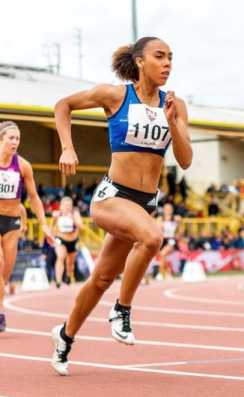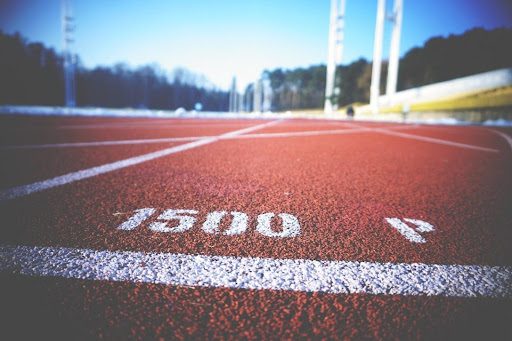Middle Distance Speed
Speed work for a middle distance runner is very similar to the more endurance based parts of a sprinters training. We can basically split this section into two parts: technique and anaerobic speed training.
Technique
Firstly, although they don't tend to work on their technique as much as a sprinter would, it is still vital to run with as good an action as possible. Some would even argue it is more important, as a poor running technique will use more energy than a good one and lead to premature fatigue in a race, meaning more technically proficient runners pulling away in the final lap of an 800 or 1500m race, having conserved more energy early on. Often the 'sit and kick' tactic is used in the final lap and it is noticeable that the runners most successful in this typically display good form and posture comparable to that of a sprinter.

Photo Middle Distance start
It is generally preferable to improve technique by practice of drills and strides prior to a session, as during runs your concentration will naturally be on the run itself.
Anaerobic Speed Training
Both the 800m and 1500m use a higher contribution of energy supply from the aerobic system compared to the anaerobic system. However training must be balanced to gain physiological improvements to both systems.
Estimated energy system contributions to the 800m and 1500m
- 800m = 60% aerobic and 40% anaerobic
- 1500m = 75% aerobic and 25% anaerobic
This means middle distance runners must perform anaerobic type speed training to develop their ability to cope with lactic acid which builds up as a waste product of the anaerobic energy system and disrupts muscle contractions to cause premature fatigue. This is why you see a number of 800m flailing down the last 100m as their body becomes overwhelmed with lactic and it becomes harder to coordinate their muscle contractions!
There is no easy way to improve this - just hard work. To improve, you must consistently expose your body to high levels of lactic acid to promote physiological adaptations so your body is better able to tolerate it.
This can be done through fast, high intensity training sessions with short recoveries.
Sessions, such as 10 x 200m with about 1-2 minutes between each run will work well for this - try to run each of these at about your 800m pace (this will be pretty tough work by the latter runs.
With this information in mind, it is also important to note that an element of working on absolute top speed is also useful. The way to think of this is if an athlete has a PB of 11.0 for 100m they will be running a 1:50 800m at 80% of maximal speed. If they have a similar fitness level to an athlete who can only run 12.4 for 100m - then this later athlete is running a 1:50 800m at 90% of top speed and their effort levels to maintain the pace will clearly be a lot higher.

